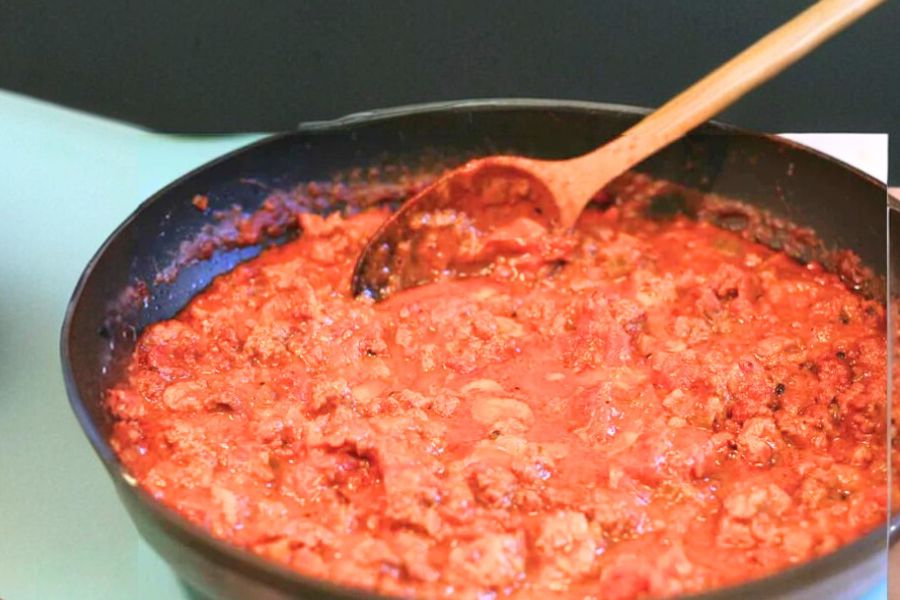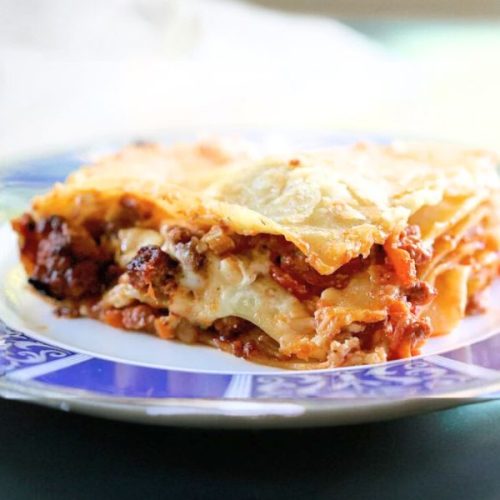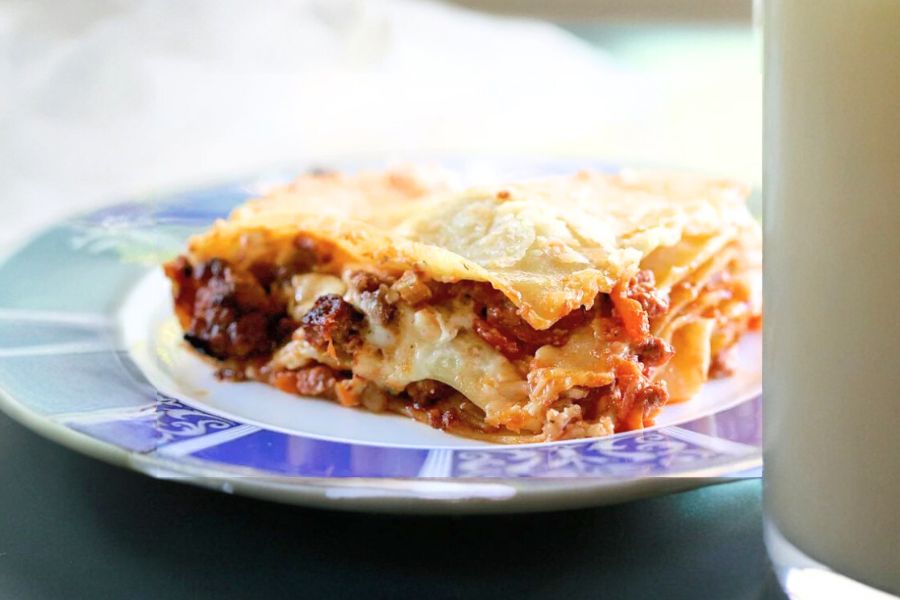This Lasagna Bolognese stands out as the perfect harmony between hearty Italian tradition and nourishing, wholesome eating.
Layers of rich, slow-simmered meat sauce mingle with velvety béchamel, creating a comforting yet refined dish that’s both satisfying and elegant.
The combination of beef, pork, and sausage delivers a robust protein punch (over 30g per serving) to fuel muscle repair and keep you full longer.
Fresh vegetables like carrots, celery, and tomatoes offer valuable fiber and antioxidants, supporting digestive health and immunity.
While indulgent in flavor, this lasagna provides healthy fats from butter and olive oil, and its balance of carbs, protein, and fats makes it a complete, energizing meal.

Perfect for Sunday dinners, special gatherings, or meal-prep, it freezes beautifully and reheats without losing its charm — making it a reliable go-to for both busy weekdays and celebratory weekends.
Must-Have Tools for Perfect Results
All-Clad Stainless Steel Sauté Pan
Ideal for browning meats and building flavor in the Bolognese; its even heat distribution ensures no hot spots and flawless caramelization. Beyond lasagna, it’s perfect for stir-fries, pan sauces, and searing.
Le Creuset Enameled Cast Iron Dutch Oven
Perfect for slow-simmering the sauce for hours without scorching, locking in deep, rich flavors. Also excels in braises, soups, and bread baking.
Pyrex 3-Quart Glass Baking Dish
Non-reactive, oven-safe, and great for layering lasagna without affecting the taste of acidic tomato sauces. A kitchen staple for casseroles, baked pasta, and desserts.
OXO Good Grips Balloon Whisk
Essential for lump-free béchamel; its comfortable grip and sturdy wires make whisking effortless. Also great for vinaigrettes, batters, and whipped cream.
KitchenAid 8-Quart Stainless Steel Stock Pot
Reliable for boiling lasagna sheets evenly; large capacity prevents overcrowding and sticking. Doubles as your go-to pot for soups, stocks, and seafood boils.

Authentic Lasagna Bolognese
Equipment
- 1 Stainless Steel Sauté Pan (for soffritto and browning meat)
- 1 Dutch Oven (for long sauce simmering)
- 1 3-Quart Glass Baking Dish (for layering and baking lasagna)
- 1 Balloon Whisk (for béchamel sauce)
- 1 Large Stock Pot (for boiling pasta)
- 1 Wooden Spoon (for stirring sauces)
- 1 Chef’s Knife (for chopping vegetables)
Ingredients
Bolognese Sauce:
- 2 oz pancetta finely diced
- 1 medium Spanish or yellow onion finely chopped
- 1 rib celery finely chopped
- 1 carrot finely chopped
- 4 tbsp unsalted butter
- 11 oz ground beef
- 4 oz ground pork
- 4 oz ground Italian sausage
- 1 pinch ground clove
- 1 dash ground cinnamon
- 1 tsp freshly ground black pepper
- 2 lbs fresh tomatoes peeled and chopped or 1 × 28-oz can whole peeled tomatoes
- 1 cup whole milk
- ½ tsp sea salt
Béchamel Sauce:
- 2 cups whole milk
- ¼ cup unsalted butter
- ¼ cup all-purpose flour
- ½ tsp sea salt to taste
Lasagna Assembly:
- ~16 sheets lasagna noodles enough for 4 layers in a 13 × 9-inch dish
- 1 cup Parmesan cheese freshly grated
- 1 tsp olive oil for greasing dish
Instructions
- Build the Flavor Base (Soffritto): Place a large stainless steel sauté pan over medium heat. Add the diced pancetta, chopped onion, celery, and carrot along with the butter. Stir gently as the vegetables release their natural sweetness and the pancetta begins to render its fat. You’re looking for the onions to turn a soft golden hue — this will take about 8–10 minutes. Keep the heat moderate so the vegetables soften without browning too quickly. This aromatic mixture is the foundation of your Bolognese, so take your time here.
- Brown the Meats: Increase the heat to medium-high.Add the ground beef, pork, and Italian sausage to the pan, breaking them apart with a wooden spoon.Stir frequently so the meat cooks evenly, allowing it to develop a rich brown crust in spots — this browning adds deep flavor to the sauce. Sprinkle in the ground clove, a dash of cinnamon, and freshly ground black pepper. These warm spices bring subtle complexity without overpowering the savory character of the sauce. Continue cooking until no pink remains.
- Add the Tomatoes and Simmer: Stir in the peeled and chopped tomatoes (or canned whole tomatoes, crushed by hand or with the back of a spoon). If using canned, break them into smaller chunks as they blend into the meat mixture. Reduce the heat to medium and let the sauce bubble gently for about 15 minutes, allowing the tomato juices to mingle with the meat and vegetables. The sauce will begin to thicken slightly and take on a deep red color.
- Enrich with Milk and Slow-Cook: Pour in the whole milk, season with sea salt, and stir well. Lower the heat to the gentlest simmer possible. Cover partially with a lid, and let the sauce cook for 2½ hours, stirring every 15–20 minutes. If the sauce reduces to the point where it sticks to the pan, add ¼ cup of water, scraping up any browned bits from the bottom to release that concentrated flavor back into the sauce. Patience here is rewarded — the longer it simmers, the silkier and richer the sauce becomes.
- Prepare the Béchamel Sauce: While the Bolognese simmers, warm the milk in a small saucepan until it’s just about to boil — you’ll see small bubbles forming around the edges.In a separate heavy-bottomed saucepan, melt the butter over low heat. Once melted, whisk in the flour to create a smooth paste (roux). Cook this for about 1 minute, whisking constantly to remove the raw flour taste. Slowly pour in half of the hot milk, whisking vigorously to prevent lumps. When smooth, add the remaining milk gradually. Continue cooking over low heat, stirring constantly, until the sauce thickens to a silky, pourable consistency. Season with sea salt and set aside. If lumps appear, beat them out with a whisk until smooth.
- Cook and Prepare the Lasagna Sheets: Bring a large stock pot of salted water to a rolling boil. Add the lasagna noodles in batches, cooking them for about 8 minutes or until they’re pliable but still slightly firm (al dente). Drain immediately and rinse briefly with cold water to stop the cooking. Lay the noodles flat on clean kitchen towels, ensuring they don’t overlap — this prevents sticking and tearing when assembling the lasagna.
- Preheat and Prepare the Baking Dish: Preheat your oven to 375°F (190°C).Lightly grease the inside of a 13 × 9-inch glass or stainless steel baking dish with a thin layer of olive oil. Avoid aluminum pans, as their reaction with tomato acids can affect the flavor.
- Assemble the Lasagna Layers: Place a layer of lasagna noodles along the bottom of the dish, slightly overlapping them. Spread one-third of the Bolognese sauce evenly over the noodles. Next, spoon one-third of the béchamel sauce over the meat, using the back of a spoon to gently spread it without disturbing the meat layer. Sprinkle generously with Parmesan cheese. Repeat this layering process two more times: noodles → Bolognese → béchamel → Parmesan. Finish with a final layer of noodles topped with a light sprinkling of Parmesan for a golden crust.
- Bake to Perfection: Cover the dish loosely with aluminum foil, tenting it so it doesn’t touch the top layer. Place in the preheated oven and bake for 20–30 minutes, or until the lasagna is heated through and the top begins to turn lightly golden. For a deeper crust, remove the foil for the last 5 minutes of baking.
- Rest and Serve: Once baked, remove the lasagna from the oven and allow it to rest for 5–10 minutes before slicing. This short wait allows the layers to set, making it easier to serve neat, beautiful portions. Plate with a side salad or garlic bread, and enjoy the fruits of your slow-cooked labor.
Notes
- Use the highest-quality meat you can find for deeper, richer flavor. Grass-fed beef and heritage pork are excellent choices.
- A mix of fresh and canned tomatoes creates a perfect balance of sweetness and acidity in the sauce.
- The béchamel sauce should be silky and lump-free — always add hot milk gradually while whisking.
- Letting the lasagna rest before slicing ensures neat portions and prevents layers from sliding apart.
- For a slightly lighter dish, you can swap whole milk for 2% in both sauces without losing creaminess.
- Freshly grated Parmesan melts better and has a more pronounced flavor than pre-shredded varieties.
- If possible, make the Bolognese sauce a day ahead — the flavors deepen beautifully overnight.
Chef’s Secrets for Exceptional Flavor
A truly memorable Lasagna Bolognese is all about patience and balance.
Start with a slow-cooked soffritto, letting the vegetables sweat gently to coax out their natural sweetness before adding the meats.
Don’t rush the browning process — those caramelized bits at the bottom of the pan are liquid gold for flavor.
When adding the milk, keep the heat low to maintain a smooth, rich texture without curdling.
Finally, assemble the lasagna with even layers, ensuring each bite delivers pasta, sauce, and cheese in perfect harmony.
Serving Suggestions for Maximum Enjoyment
This lasagna shines as the centerpiece of a cozy family dinner or a festive gathering.
Pair it with a crisp green salad dressed in a light vinaigrette to cut through the richness, or serve alongside roasted seasonal vegetables for extra color and nutrition.
Garlic bread or a warm focaccia makes a delightful side, ideal for soaking up any extra sauce.
For wine lovers, a bold red such as Chianti Classico or Barbera complements the hearty flavors beautifully.
Finish with a light dessert like lemon sorbet or panna cotta to balance the meal.
Storage Tips for Freshness and Flavor
Lasagna Bolognese stores exceptionally well, making it a smart choice for meal prep.
Once cooled to room temperature, cover the baking dish tightly with foil or transfer portions to airtight containers.
It will keep in the refrigerator for up to 4 days. For longer storage, freeze portions individually to make reheating more convenient — it will keep for up to 3 months.
When reheating from frozen, thaw overnight in the fridge and warm in the oven at 350°F until heated through.
Avoid microwaving large portions, as it can cause uneven heating and rubbery pasta.
Frequently Asked Questions About Lasagna Bolognese
1. Can I use fresh pasta sheets instead of dried?
Yes! Fresh pasta sheets can be used directly without pre-cooking. They will absorb sauce as they bake, creating a softer, more delicate texture.
2. What’s the best way to make it ahead?
You can prepare the sauce and béchamel up to two days in advance. Assemble the lasagna the day before baking, store it covered in the fridge, and bake when ready to serve.
3. How do I prevent watery lasagna?
Allow the sauce to simmer long enough to reduce excess liquid, and make sure the pasta is well-drained. Resting the lasagna after baking also helps set the layers.
4. Can I substitute the meats in the sauce?
Absolutely. Try using ground turkey or chicken for a lighter version, or omit the meat entirely and use mushrooms and lentils for a hearty vegetarian option.
5. What’s the difference between Bolognese and regular meat sauce?
Bolognese is a slow-cooked Italian meat sauce with a base of soffritto, milk, and wine (or in this version, just milk), resulting in a rich, creamy texture — unlike quick tomato-based meat sauces.
This recipe has been adapted and simplified from the original version by simplyrecipes. We’ve refined the steps for a smoother cooking experience and added helpful notes, nutrition insights, and essential kitchen tools to make it even easier for home cooks.

